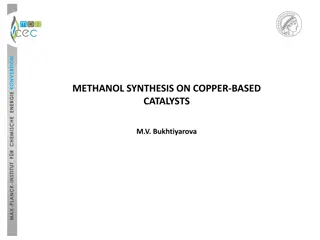Understanding Methanol Metabolism and Blood Levels
This content discusses the difference between background/endogenous and exogenous methanol, how metabolism of endogenous methanol affects exogenous metabolism, and the impact of exposure to different levels of methanol on blood concentrations. It highlights EPA PBPK models and assumptions regarding average background levels and provides insights into exposures exceeding background levels.
Download Presentation

Please find below an Image/Link to download the presentation.
The content on the website is provided AS IS for your information and personal use only. It may not be sold, licensed, or shared on other websites without obtaining consent from the author. Download presentation by click this link. If you encounter any issues during the download, it is possible that the publisher has removed the file from their server.
E N D
Presentation Transcript
Methanol Listening Session May 26, 2011
Issues 1. Draft Assessment assumes there is somehow a difference between background/endogenous methanol and exogenous methanol. What constitutes background methanol? Where does it come from? Are food sources included?
Issues 1. Endogenous vs. exogenous How does metabolism of endogenous MeOH affect metabolism of exogenous? What exposure to exogenous MeOH causes an increase in blood methanol beyond the background level? Does exposure to 0.4 mg/kg/day (RfD) to a person with low background MeOH (0.6 mg/L) have the same effect as in a person with a high background level (4.0 mg/L)?
Blood Levels of Methanol by RfC Using EPA PBPK model, as published: 24 hr exposure at RfC (2 ppm) increase in blood methanol = 0.042 mg/L Equals 2.1% of EPA s assumption of average background/endogenous level of methanol Total blood methanol would be 2.042 mg/L; background levels reported to be between 0.6 and 4.0 mg/L
Blood Levels of Methanol by RfD Using EPA PBPK model, as published: Single Bolus exposure at RfD (0.4 mg/kg) increase in blood methanol = 0.264 mg/L Equals 13% of EPA s assumption of average background/endogenous level of methanol Total blood methanol would be 2.264 mg/L; background levels reported to be between 0.6 and 4.0 mg/L
Blood Levels of Methanol by RfD Using EPA PBPK model, as published: RfD (0.4 mg/kg) as 6 Bolus exposures @4hrs peak increase in blood methanol = 0.079 mg/L Equals 3.9% of EPA s assumption of average background/endogenous level of methanol Total blood methanol would be 2.079 mg/L; background levels reported to be between 0.6 and 4.0 mg/L
Upper limit of measured background level 4.0 mg/L Blood methanol, mg/L RfD exposure 0.08 mg/L RfC exposure 0.04 mg/L EPA fixed assumption of background level 2.0 mg/L Lower limit of measured background level 0.6 mg/L
Methanol Above Background Table 3-1: Background blood levels 0.6-4.0 mg/L; EPA PBPK assumes everyone at 2.0 mg/L Table B-5: Blood level by oral exceeds background only from exposure greater than 40 mg/kg/day Blood level by inhalation exceeds background only from exposure greater than 100 ppm
Conclusion from RfC, RfD IRIS assessment assumes there is no toxicity from background/endogenous methanol. EPA assumes average background = 2 mg/L Proposed IRIS indicates that anyone exposed above 0.4 mg/kg/day orally or 2 ppm via inhalation, is in danger of developmental effects Given that 50% of people may have background/endogenous level above 2 mg/L, the IRIS assessments means that 50% of people are in danger of developmental effects from their own metabolism.
Conclusion Blood level of methanol exceeds the endogenous/background range (up to 4 mg/L) only by exposures that are 50-100 times the proposed RfC and RfD levels. NAS review of formaldehdye raised the same issues. Toxicity evaluation must take into account endogenous level.
Methanol Metabolism to Formaldehyde The draft assessment assumes that the amount of methanol metabolized to formaldehyde is an appropriate measure of exposure to reactive compounds. If formaldehyde is the toxic entity from methanol, toxicity is dependent on the concentration present, not the amount formed.
Methanol Metabolism to Formaldehyde Formaldehyde (from methanol) would only be a concern for toxicity if the concentration in certain cells increased following methanol exposure. Endogenous formaldehyde forms DNA adducts in all cells. The Adduct level is fairly constant and can be a measure of formaldehyde concentration in the cell.
Methanol Metabolism to Formaldehyde Exposure to 2000 mg/kg/day methanol orally for 5 days resulted in small increases in the FA- dG or dA adducts in rats (Swenberg, 2011 SOT abstract)
Methanol DNA adducts dG-FA adducts as % of endogenous Dose (mg/kg/day) 2000 500 Liver 5 1 Lung 2 2 Kidney 5 1 Spleen 18 3 Bone Marrow 42 12 Thymus 11 0 Blood cells 5 0 Brain 0 0
Methanol DNA adducts dA-FA adducts as % of endogenous Dose (mg/kg/day) 2000 500 Liver 0 0 Lung 0 0 Kidney 9 0 Spleen 0 0 Bone Marrow 29 1 Thymus 0 0 Blood cells 0 0 Brain 0 0
Metabolism Conclusion Metabolism of methanol in rats exposed to near lethal doses of methanol results in minimal increases in intracellular formaldehyde























